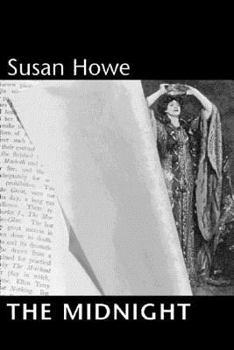The Midnight
Select Format
Select Condition 
Book Overview
In The Midnight's amply illustrated five sections, three of poetry and two of prose, we find--swirling around the poet's mother--ghosts, family photographs, whispers, interjections, bed hangings, unfinished lace, the fly-leaves of old books, The Master of Ballantrae, the Yeats brothers, Emily Dickinson, Lewis Carroll, Lady Macbeth, Thomas Sheridan, Michael Drayton, Frederick Law Olmsted: a restless brood confronting, absorbing, and refracting history and language. With shades of wit, insomnia, and terror, The Midnight becomes a kind of dialogue in which the prose and poetry sections seem to be dreaming fitfully of each other.
Format:Paperback
Language:English
ISBN:0811215385
ISBN13:9780811215381
Release Date:May 2003
Publisher:New Directions Publishing Corporation
Length:224 Pages
Weight:0.65 lbs.
Dimensions:0.6" x 6.1" x 9.1"
Customer Reviews
2 ratings
Hanging In The Balance
Published by Thriftbooks.com User , 19 years ago
Just about the best of Howe's recent books THE MIDNIGHT is jampacked with allusion, drama, and poetry, sometimes withdrawn seductively from the reader, hidden in a clutch of quotations, and at other times lowered, as if from a great heught, tantalizingly in your face. She has always been one to look underneath the surface of things; as an actress her training was in the Poets Theater of Cambridge, and her mother was the famous Mary Manning of Dublin's Abbey Theater. Thus there's a tendency to examine, sometimes at length, the underside of process, the thickness of what we do and especially what we say, when writing takes place, as the wind that reveals the silver underside of the leaves we'd otherwise never notice. THE MIDNIGHT is fairly shaking with sadness, regret, and the stern obligations of memory, as Howe again scans the marginalia of another. This time it's her late uncle and the books he left behind in a seemingly otherwise blank (or pathetic) existence, specifically his copies of R L Stevenson-the novelist admired above all others by Howe's hero Henry James. As she turns the pages of the novel, parts of her uncle's life (and family photographs) seem to pop out like something from a Nick Bantock novel, but it's all part of Howe's finely tuned poetry machine, the unexpected choice of word and quotation, the sizzle of disjunction and more than anything else, the shiver of anticipation that one is getting something from this poetry unavailable elsewhere, a direct pipeline into a strain of American experience that the past has otherwise denied us. It's suspenseful, and fun too, like an Indiana Jones movie. Don't let people tell you differently.
"Syllabic magic"
Published by Thriftbooks.com User , 21 years ago
The verbal shades/shards are here accompanied by intrigue in the form of photographs. Pictures of books, books depicted in her words. That combination makes this book something unexpected, though we expect and are rewarded by her challenges. Traversing from abandoned concrete and a forgotten train station in Buffalo to the closed cloister where Emily Dickinson's manuscripts are kept, and many other places in between, the range of subjects and objects here does not fail to hold the reader. How such wideness of topic can be spun into such compelling narrative is the mystery we admire. And there is humor here, also. So this could be a good first book of hers to read, or it could be said to pick up where Pierce-Arrow left off, with a thread or two from Frame Structures and Bed Hangings pursued to even greater effect. Buy, enjoy, learn from this book.





